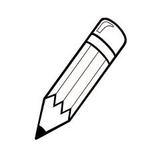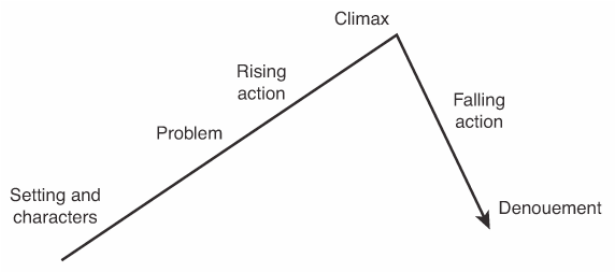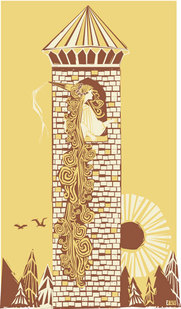let's talk about
Narrative structure
How you structure your narrative is completely up to you!
Below are suggestions for how a story could be structured but we want to encourage you to think beyond these examples.
Sophisticated Structures
Consider using a structure other than the typical linear, time-sequenced model.
Some alternatives are offered below. Read through the list and try and think of a narrative you know that uses this structure. What is the effect of this structure on the reader?
A Circular narrative:
Circular narratives begin and end in the same location. They place emphasis on the knowledge we have grained through the narrative. Often the characters will behave differently when they return to the original location, because they have learned something during the story.
Consider The Lion The Witch and The Wardrobe, which both begins and ends with the children at the train station. What knowledge have we gained between the time we first saw these children and the close of the narrative? How does this circular narrative emphasise the progress the children have made during the story?
A Parallel narrative:
Parallel narratives offer more than one story alongside one another. Often these stories come together at some point, or else they have similar themes. On the other hand, they may be used to emphasise the potential for characters to deal with similar situations in different ways. Parallel narratives often have more than one location and more than one protagonist.
Consider The Parent Trap, which follows both the twins, as they live with their respective parents. Parrallelism can also be used only briefly in a narrative. In Hamlet, Fortinbras' story is offered as a parallel to Hamlet's. Why? What does his story teach us about Hamlet's?
Framing:
Similar to circular narratives, framing is a device used to 'bookend' a narrative. You can frame a story with a metaphor that you begin and end with, or an image, or a quote. The novel, Frankenstein, is framed by the letters of Walton, which begin and end the narrative. Framing is often used to emphasise the moral meaning or message of the narrative in a non-explicit way.
Some other interesting structural devices to consider include:
- Stories within Stories
- Epiphany
- Foreshadowing and Flashbacks
- Sideline or Back Stories
Below is a narrative graph, outlining the typical events occurring in a narrative, and their sequence.
Often the more interesting stories are the ones that mix up this sequence. Perhaps they delve straight into a climactic moment and then later introduce the setting and characters. Other stories have a smaller climax and a less emphasised denouncement, leaving the reader to think about the meaning of the narrative.
Sophisticated Structures
Consider using a structure other than the typical linear, time-sequenced model.
Some alternatives are offered below. Read through the list and try and think of a narrative you know that uses this structure. What is the effect of this structure on the reader?
A Circular narrative:
Circular narratives begin and end in the same location. They place emphasis on the knowledge we have grained through the narrative. Often the characters will behave differently when they return to the original location, because they have learned something during the story.
Consider The Lion The Witch and The Wardrobe, which both begins and ends with the children at the train station. What knowledge have we gained between the time we first saw these children and the close of the narrative? How does this circular narrative emphasise the progress the children have made during the story?
A Parallel narrative:
Parallel narratives offer more than one story alongside one another. Often these stories come together at some point, or else they have similar themes. On the other hand, they may be used to emphasise the potential for characters to deal with similar situations in different ways. Parallel narratives often have more than one location and more than one protagonist.
Consider The Parent Trap, which follows both the twins, as they live with their respective parents. Parrallelism can also be used only briefly in a narrative. In Hamlet, Fortinbras' story is offered as a parallel to Hamlet's. Why? What does his story teach us about Hamlet's?
Framing:
Similar to circular narratives, framing is a device used to 'bookend' a narrative. You can frame a story with a metaphor that you begin and end with, or an image, or a quote. The novel, Frankenstein, is framed by the letters of Walton, which begin and end the narrative. Framing is often used to emphasise the moral meaning or message of the narrative in a non-explicit way.
Some other interesting structural devices to consider include:
- Stories within Stories
- Epiphany
- Foreshadowing and Flashbacks
- Sideline or Back Stories
Below is a narrative graph, outlining the typical events occurring in a narrative, and their sequence.
Often the more interesting stories are the ones that mix up this sequence. Perhaps they delve straight into a climactic moment and then later introduce the setting and characters. Other stories have a smaller climax and a less emphasised denouncement, leaving the reader to think about the meaning of the narrative.

Task 2: Due Week 3
Click on the image of 'Rapunzel' below and read the famous fairytale. Consider the narrative structure of Rapunzel. Rewrite the fairytale, mixing up the narrative structure and employing some for the devises mentioned above. Upload your revised narrative onto the discussion board under the 'Task Two' tab.


